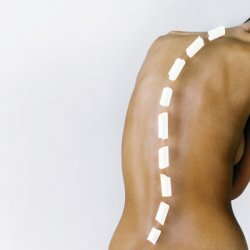Pain in the leg from the knee to the foot
 Pain in the leg from the knee to the foot - a very common phenomenon.The causes of this symptom in different age categories are not the same.In young people, leg pain is often caused by excessive physical exertion and trauma.But in middle-aged people, the common cause of the onset of pain are diseases of the vessels of the lower limb.
Pain in the leg from the knee to the foot - a very common phenomenon.The causes of this symptom in different age categories are not the same.In young people, leg pain is often caused by excessive physical exertion and trauma.But in middle-aged people, the common cause of the onset of pain are diseases of the vessels of the lower limb.
Causes of pain
The lower part of the leg from the knee and the foot is called the shin.The lower leg is formed by two bones: tibia and fibula.Above to these bone structures is the patella.From below, the tibial and fibular bones together with the talus bone of the foot form the ankle joint.Distinguish the anterior and posterior surface of the tibia.
It's safe to assume that with pain in the lower leg is familiar to almost everyone.Indeed, excessive motor activity, when what is called the whole day on your feet, by the evening makes itself felt by the pain in the shin.But behind the pain can hide and independent diseases, to identify which in time is extremely important.
All possible causes of the development of shin pain can be divided conditionally into the following categories:
-
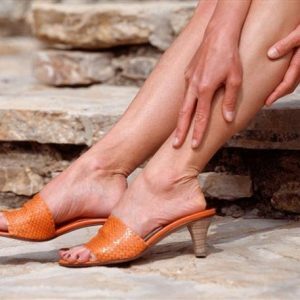 Injuries to the shin;
Injuries to the shin; - Diseases of the vessels of the feet;
- Inflammatory diseases of the bones and soft tissues of the lower leg;
- Diseases of the spine;Diseases of the peripheral nervous system.
Injury of the calf
In medical practice, leg injuries are common.Particularly susceptible to this injury are sportsmen - runners, football players, figure skaters. Injury of the lower leg is a collective concept, which includes:
- Fracture of the leg bones( tibial or fibula, patella);
- Dislocation of lower leg;
- Chest injuries;
- Stretching or tearing of the leg muscles;
- Stretching of the ligaments of the lower leg.
As a rule, the definition of the diagnosis of "shin injury" is not difficult.The onset of pain is preceded by a blow in the leg, a fall on it, or strong physical exertion.Injury accompanied by edema of the shin, formation of bruises, restriction of leg mobility. In case of fractures, the shin can deform, take an unnatural position, which is noticeable even with the naked eye.In order to confirm or refute the fracture of the lower leg, it is necessary to make an X-ray.
Diseases of the vessels of the lower extremity
From the condition, the tone of the vessels of the lower limb depends on the complete blood supply, nutrition of the calf tissues.When a disease of the vessels of the human shin is worried about the feeling of heaviness in the legs and even pain at the end of the day. To the appearance of pain from the knee to the foot can cause such diseases as:
- Obliterating atherosclerosis;
- Obliterating endarteritis;
- Varicose veins;
- Acute thrombosis of the lower leg;
- Postthrombophlebitic syndrome.
Chronic occlusive diseases of arteries
Atherosclerosis and obliterating endarteritis are classified as chronic occlusive diseases of the arteries.These diseases though have also the various reasons, mechanisms of development, but are shown by rather similar signs.The basis of occlusive diseases is a gradual narrowing of the arteries, which ends with the obstruction of the vessels.As a result, blood supply to the tissues of the limb is impaired, which leads to the development of trophic disorders and the appearance of pain.
Symptoms of obliterating endarteritis are similar to those of obliterating atherosclerosis . So, chronic occlusive diseases manifest themselves with such symptoms:
- Increased fatigue in the legs;
- Chilliness of the feet;
- Paresthesia( numbness, crawling sensations on the skin);
- Pale skin( marbling) and cyanosis of toes;
- Intermittent claudication( intermittent walking with forced respites due to acute aches and pains that occur after a short rest);
- Pain in the lower leg, at rest and at night - are noted in the late stages of the disease;
- Thinning of the skin, trophic ulcers;
- Atrophy of the calf muscles.
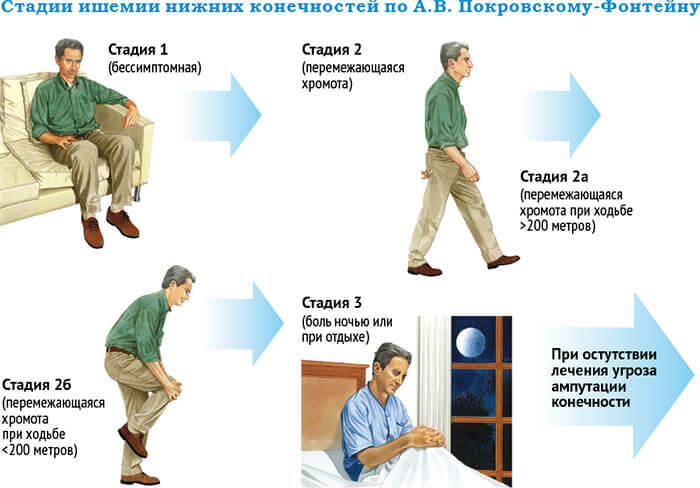
Varicose veins
Foot pain from the knee to the foot can also be a manifestation of varicose veins of the lower extremities.Normally, the blood flow goes through the veins of the legs from the periphery to the center, and along the communicating veins - from the surface to the deep. In varicose cases, the blood flow is directed from the center to the periphery, from the deep veins of the legs to the superficial ones.This is the so-called perverted blood flow.As a result, venous insufficiency develops.
At the initial stage of a person's illness, only the feeling of heaviness, of raspiraniya in the legs after physical exertion and at the end of the day is disturbed.However, these symptoms after rest, in the morning pass.In the future, varicose veins are clearly visible on the lower leg, edema of the lower leg and foot develop, cramps calves, trophic ulcers on the skin. As the disease progresses, the pains in the lower leg become a faithful companion of the person, who extract it around the clock.
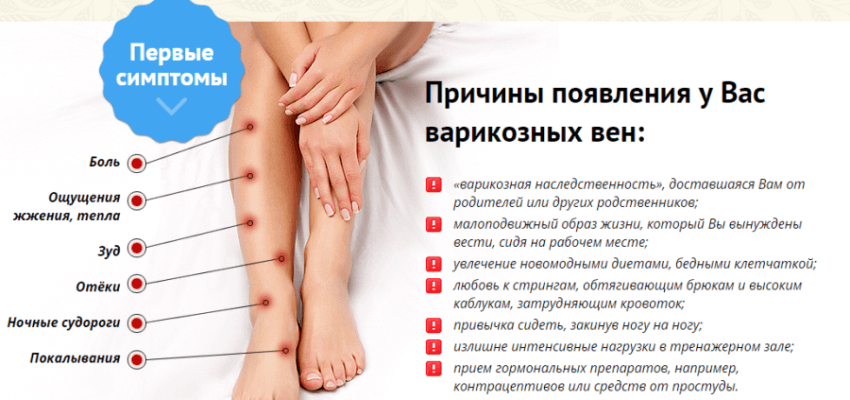
Acute thrombosis of veins
The most dangerous cause of pain from knee to foot is acute deep vein thrombosis of the shin .In the thrombosis of the superficial veins of the human shin, pain and the presence of a painful compaction on the tibia along the vein, obstructed walking, are of concern. When deep vein thrombosis of the lower leg is noted:
- Edema of the lower leg;
- Cyanosis of the foot;
- Scalping pains in the tibia, aggravated by movement;
- General weakness;
- Elevated body temperature.
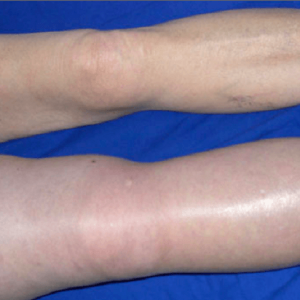 The most formidable complication of acute deep vein thrombosis is the possibility of detachment of a thrombus and its entry into the pulmonary artery, which can lead to death.
The most formidable complication of acute deep vein thrombosis is the possibility of detachment of a thrombus and its entry into the pulmonary artery, which can lead to death.
That's why, if in addition to leg pain from knee to foot, the person has the above symptoms, you need to contact a surgeon to prevent complications of the disease.
Inflammatory diseases of the bones and soft tissues of the lower leg
The cause of foot pain from the knee to the foot may be concealed directly in the pathology of the shin bones.So, the inflammation of the bone tissue of the shin is called the osteomyelitis .Infection of the bone can occur endogenously by penetrating the bacterium from existing festering foci in the body.This type of osteomyelitis is characteristic of childhood.Another way of infection of the bone is exogenous, when bacteria enter the bone tissue from the environment with open fractures, operations on the shins.
Shin osteomyelitis begins acutely. At the beginning of the disease a person observes unexplained weakness, malaise, fever, chills.After a few days there is intense pain in the region of the shin, which is intensified by the slightest movements. The drumstick is swollen, the skin is red and hot to the touch.A purulent process can also affect the knee or ankle joints.In the absence of treatment and the presence of non-opening abscess, sepsis develops.

In inflammation of skeletal muscles, myositis develops.The disease can cause trauma, toxic effects, infectious diseases( ARVI, tonsillitis), connective tissue diseases, etc. The main signs of the shin myositis are:
- Aching in the leg, worse when moving and touching the affected muscles;
- Often in the inflamed muscles, dense nodules and cords are probed;
- Local redness of the shin and some swelling may also be noted.
Infection of the soft tissues of the lower leg can also cause foot pain from the knee to the foot. For example, erysipelas can capture a large portion of the shin, which causes diffuse burning pains on the leg. A characteristic feature of the disease is the appearance on the skin of a red spot with uneven borders in the form of flame tongues.The shin is swollen in this area, the skin feels hot.The general state of health of a person suffers as well: fever, weakness, malaise are noted.
The phlegmon of the lower leg is also accompanied by painful sensations in the shin.This purulent diffuse inflammation of the soft tissues.Phlegmon is manifested not only with pain, but with swelling of the lower leg, reddening of the skin.General signs of toxicity are also noted.Absence of treatment can lead to the development of sepsis.
Spine diseases
The leg muscles are innervated by two basic nerves: tibial and common peroneal.These nerve fibers are formed from the sciatic nerve in the popliteal fossa region.In turn, the sciatic nerve originates from the sacral nerve plexus formed by the spinal nerves .The defeat of nerve fibers at any level, ranging from spinal nerves, ending with nerve branches directly in the region of the shin, may manifest as a pain syndrome.
Spinal injury in the lumbosacral spine can lead to compression of the spinal nerves and, as a consequence, the appearance of pain in the shin. These are such diseases of the spine as:
- Osteochondrosis;
- Protrusion of the intervertebral disc;Hernia of the intervertebral disc.
When squeezing the spinal roots at the level of the lumbosacral spine, pain occurs that radiate to the buttock, thigh, shin, and foot of the .Any careless movement provokes increased pain.Paresthesias are also noted in the form of numbness, the sensation of crawling along the surface of the foot skin.
Diseases of the peripheral nervous system
Non-inflammatory lesion of the peripheral nerves is called neuropathy.In general, neuropathies can occur with compression, nerve trauma, metabolic disorders of the body, toxic effects.
When compressing( compressing) peripheral nerves in the anatomical narrowing( canals) surrounding musculoskeletal structures, the pathological condition tunneling neuropathy develops.Thus, , when the common peroneal nerve of the person is compressed, is pained by the external surface of the shin and the foot, paresthesia in the form of numbness, sensation of crawling in this area .There is also a violation of extension of the foot and fingers, difficulty in withdrawing the outer edge of the foot.When walking, a man raises his leg high, this gait is called "horse".
When the tibial nerve is compressed in the tarsal canal, the tarsal channel syndrome develops.Symptoms of this ailment are pain in the area of the inner ankle and foot( sometimes in the shin), a violation of sensitivity in this area in the form of burning, tingling of the skin, a violation of the movement of the foot, a change in gait.
In their practice, doctors often face diabetic neuropathy of the lower limbs.Patients with diabetic neuropathy are disturbed by pain in the shin and foot, a feeling of crawling, burning of the skin, and night cramps of the calf muscles.With long-lasting neuropathy, the muscles of the lower leg are atrophied, and the non-healing trophic ulcers appear on the skin.
Pain in the leg from the knee to the foot can really be triggered by various diseases.To find out the root cause of pain, it is extremely important to take into account additional symptoms, the age of the patient, the concomitant diseases.
Grigorova Valeria, medical reviewer



